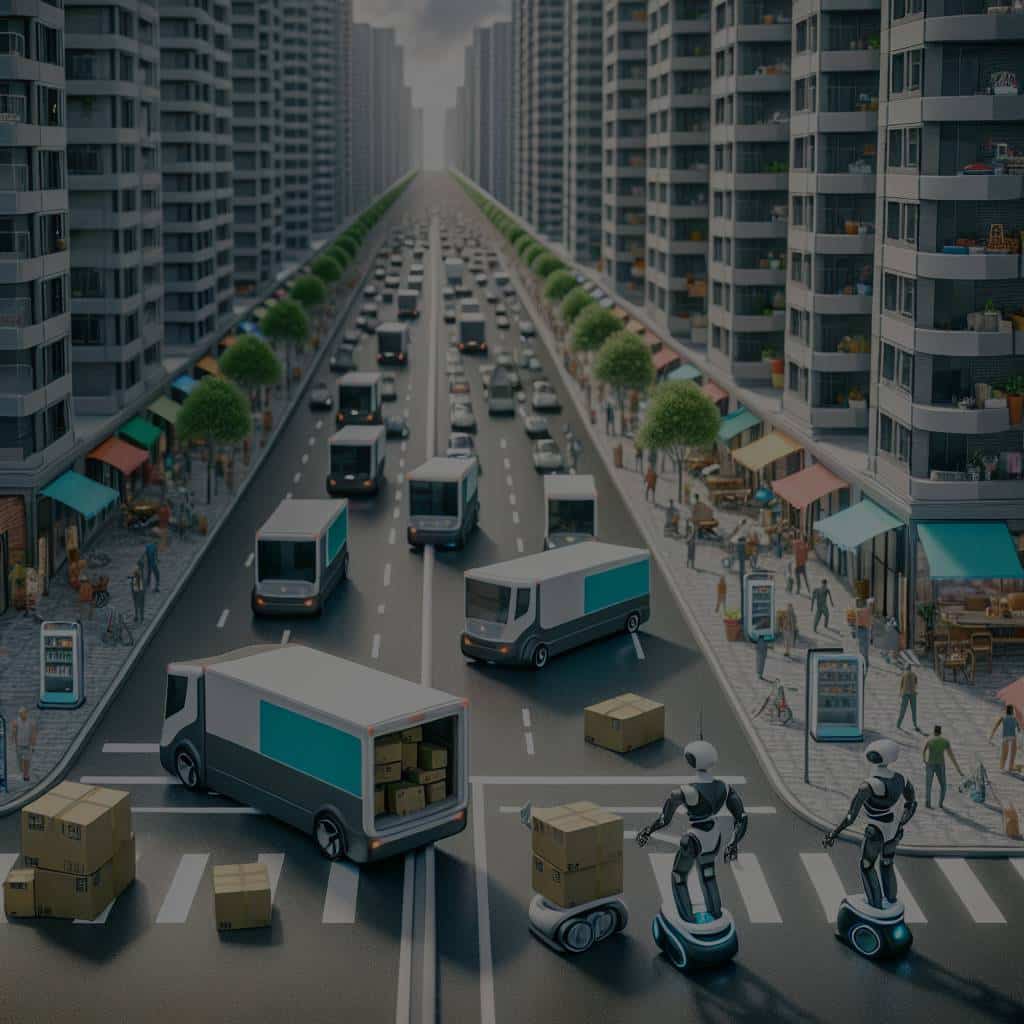In an era of rapidly evolving technology, the logistics sector has not been left behind. The demand for quick, efficient, customer-centric services is rising. As you navigate this landscape, you will come across a game-changing innovation – autonomous delivery robots (ADRs). Backed by powerhouses like Google Scholar, these vehicles are set to revolutionize last-mile delivery and urban logistics.
Autonomous Delivery Robots – Revolutionizing Delivery Solutions
Imagine sitting in your living room, and a robot stops by your door, delivering your online order within minutes of placing it. The advent of autonomous delivery robots is transforming this imagination into reality.
Topic to read : Can Smart Contact Lenses Transform the Future of Augmented Reality?
Employing advanced technology in transportation solutions, ADRs are self-driving vehicles designed to transport goods from the retailer to the customer’s doorstep. These vehicles have a compartment to store the products, a navigation system to find the path, and sensors to avoid obstacles and ensure safe travel.
This concept, although new, is not purely theoretical. In January 2021, Alphabet’s Wing became the first drone delivery service to hit 100,000 deliveries. While ADRs are becoming more common, it’s worth investigating the impact they could have on last-mile delivery and urban logistics.
Also to discover : How Is Blockchain Contributing to the Creation of Decentralized Social Media Platforms?
Time Efficiency in Last-Mile Delivery
The term ‘last-mile delivery’ refers to the final leg of the delivery process when an item moves from a transportation hub to its final destination. This stage is critical as it heavily impacts customer satisfaction and has traditionally been plagued with challenges such as traffic congestions, incorrect addresses, and customer unavailability.
Autonomous delivery robots can bring a sea change in tackling these issues. Equipped with GPS, artificial intelligence, and data analytics, these vehicles can calculate the most efficient routes, avoid traffic, and deliver packages at the exact time customers are available.
Moreover, ADRs can operate around the clock, ensuring delivery at any time. This 24/7 service could not only improve customer satisfaction but also reduce delivery time, leading to a significant increase in logistical efficiency.
Reducing Operational Costs in Urban Logistics
Urban logistics involves the movement, storage, and flow of goods into, out of, and within a city. It’s a complex process that requires efficient management to minimize costs, reduce delivery time, and maximize customer service.
Autonomous delivery robots, with their advanced technology, can streamline urban logistics by reducing operational costs. These robots do not require driver wages, thereby saving significantly on labor costs. Moreover, they are usually electrically powered, which lowers fuel costs.
Additionally, ADRs are designed to handle small to medium-sized packages, ideal for urban settings where most deliveries involve small items. This could reduce the need for large delivery trucks in city centers, saving on vehicle maintenance costs, and mitigating environmental pollution.
Meeting Customer Demand with Advanced Technology
Customer demand is an essential driver in the world of logistics and delivery. The rise of e-commerce has led to customers expecting fast, reliable, and flexible delivery options.
With autonomous delivery robots, businesses can meet these expectations head-on. Customers can use an app to track their deliveries in real-time, schedule delivery times that suit them, and even communicate with the robots. This level of interaction and customization can lead to high customer satisfaction and loyalty.
Moreover, ADRs equipped with advanced technology can cater to the increasing demand for contactless delivery in the wake of COVID-19. Robots can deliver packages without any human interaction, ensuring safety and peace of mind for customers.
Integrating ADRs into Existing Logistics Infrastructure
While autonomous delivery robots hold immense potential, integrating them into the existing urban logistics infrastructure can be challenging.
Cities would need to build robot-friendly infrastructure, such as designated lanes or pickup points. There would also be regulatory issues to address, such as defining where and when robots can operate, ensuring they adhere to traffic rules, and establishing liability in case of accidents.
Companies would need to amend their logistics strategies to accommodate robot deliveries. This could involve redesigning warehouse operations, modifying supply chain management, and retraining staff. Despite these challenges, the benefits ADRs bring to last-mile delivery and urban logistics are compelling enough to warrant serious consideration.
In conclusion, autonomous delivery robots have the potential to revolutionize last-mile delivery and urban logistics. They can enhance time efficiency, reduce operational costs, meet customer demand, and integrate advanced technology into the delivery process. While integration challenges exist, the benefits of ADRs could make them a mainstay in the future of delivery.
Leveraging Autonomous Delivery Robots for Last-Mile Logistics
The term ‘last-mile logistics’ is pivotal in the supply chain process. It refers to the final step of delivery, when a product leaves the transportation hub to arrive at its destination. The efficiency of this step significantly affects customer satisfaction.
With the introduction of autonomous delivery robots (ADRs), last-mile logistics is set for a significant overhaul. ADRs, equipped with features such as GPS, artificial intelligence, and real-time data analytics, are capable of calculating the quickest routes and avoiding traffic congestion. They can also deliver packages at precise time windows deemed convenient by customers.
Another critical aspect is their ability to operate 24/7. Unlike traditional delivery vehicles driven by humans that are restricted by working hours, ADRs can deliver round the clock. This not only ensures customer satisfaction through timely delivery but also increases logistical efficiency.
However, integrating ADRs into the existing last-mile logistics will not be without challenges. Regulatory issues, such as defining operational boundaries, adhering to traffic regulations, and setting liability rules in case of accidents, will have to be addressed. Moreover, businesses would need to redesign their existing workflows, including warehouse operations and supply chain management, to accommodate the ADRs.
The Future of Urban Logistics with Autonomous Delivery Robots
Urban logistics involves the movement and flow of goods into, out of, and within a city. With the rise in e-commerce and customer demand for quick and efficient delivery, urban logistics has become a complex process.
Autonomous delivery robots can potentially transform urban logistics by significantly reducing operational costs. These robots eliminate the need for driver wages, hence saving on labor costs. They are usually electrically powered, reducing fuel expenses further.
Moreover, ADRs are designed to handle small to medium-sized packages, which aligns with the nature of most city deliveries. This can lead to a decrease in the usage of large delivery trucks, hence reducing vehicle maintenance costs and environmental pollution.
However, cities will need to build robot-friendly infrastructure, such as dedicated lanes or pickup points, to seamlessly integrate ADRs into urban logistics. The transition will also come with its share of regulatory challenges.
In conclusion, autonomous delivery robots promise to redefine last-mile delivery and urban logistics by boosting efficiency, slashing operational costs, and enhancing customer satisfaction. Despite the integration challenges, it’s hard to ignore the substantial benefits of ADRs. As technology continues to advance, ADRs could become an integral part of the delivery solutions of the future.






